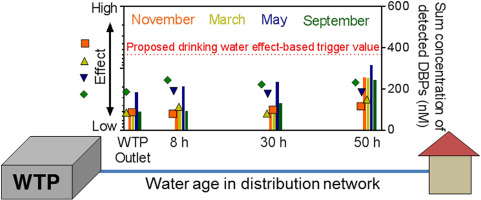Water Research ( IF 12.8 ) Pub Date : 2018-01-03 , DOI: 10.1016/j.watres.2017.12.078 Armelle Hebert , Cedric Feliers , Caroline Lecarpentier , Peta A. Neale , Rita Schlichting , Sylvie Thibert , Beate I. Escher

|
Drinking water can contain low levels of micropollutants, as well as disinfection by-products (DBPs) that form from the reaction of disinfectants with organic and inorganic matter in water. Due to the complex mixture of trace chemicals in drinking water, targeted chemical analysis alone is not sufficient for monitoring. The current study aimed to apply in vitro bioassays indicative of adaptive stress responses to monitor the toxicological profiles and the formation of DBPs in three drinking water distribution systems in France. Bioanalysis was complemented with chemical analysis of forty DBPs. All water samples were active in the oxidative stress response assay, but only after considerable sample enrichment. As both micropollutants in source water and DBPs formed during treatment can contribute to the effect, the bioanalytical equivalent concentration (BEQ) approach was applied for the first time to determine the contribution of DBPs, with DBPs found to contribute between 17 and 58% of the oxidative stress response. Further, the BEQ approach was also used to assess the contribution of volatile DBPs to the observed effect, with detected volatile DBPs found to have only a minor contribution as compared to the measured effects of the non-volatile chemicals enriched by solid-phase extraction. The observed effects in the distribution systems were below any level of concern, quantifiable only at high enrichment and not different from bottled mineral water. Integrating bioanalytical tools and the BEQ mixture model for monitoring drinking water quality is an additional assurance that chemical monitoring is not overlooking any unknown chemicals or transformation products and can help to ensure chemically safe drinking water.
中文翻译:

饮用水中适应性应激反应的生物分析评估:区分微量污染物和消毒副产物的预测工具
饮用水中可能含有少量的微量污染物,以及消毒剂与水中有机物和无机物反应形成的消毒副产物(DBP)。由于饮用水中微量化学物质的复杂混合,仅进行有针对性的化学分析不足以进行监测。当前的研究旨在在体外应用指示适应性应激反应的生物测定法,以监测法国三个饮用水分配系统中的毒理学特征和DBP的形成。生物分析辅以40种DBP的化学分析。所有水样品在氧化应激反应测定中均具有活性,但仅在大量样品富集之后才具有活性。由于水源中的微量污染物和处理过程中形成的DBP均可起到作用,因此首次采用生物分析当量浓度(BEQ)方法确定DBP的贡献,发现DBP贡献了17%至58%的DBP。氧化应激反应。此外,BEQ方法还用于评估挥发性DBP对观察到的影响的贡献,与通过固相萃取富集的非挥发性化学品的测量效果相比,检测到的挥发性DBP的贡献很小。在分配系统中观察到的影响低于任何关注的程度,只能在高浓缩时才能量化,与瓶装矿泉水没有区别。集成生物分析工具和BEQ混合模型以监测饮用水质量,是对化学监测不会忽略任何未知化学物质或转化产物的补充保证,并且可以帮助确保化学安全的饮用水。



























 京公网安备 11010802027423号
京公网安备 11010802027423号